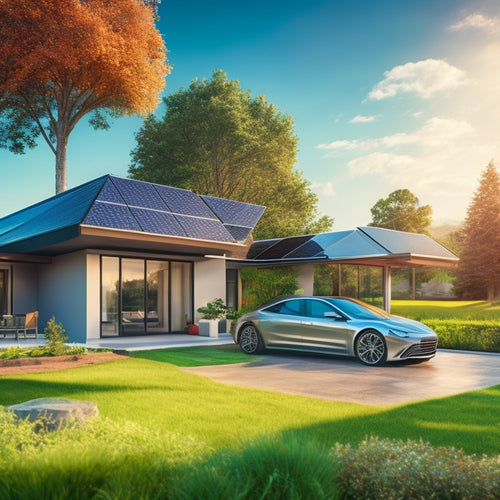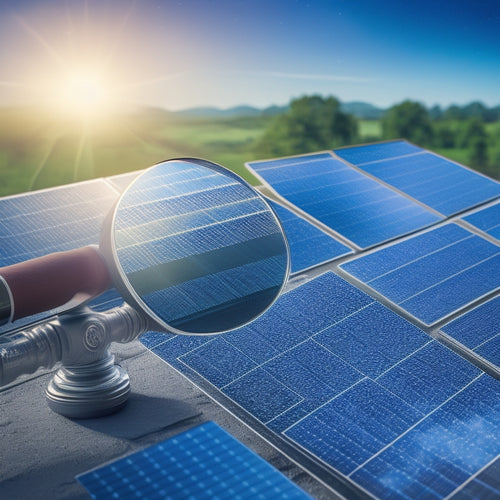
Essential Components of Commercial Solar Panel Systems
Share
When designing a commercial solar panel system, you'll need to take into account several critical components to guarantee peak energy production, longevity, and safety. You'll need high-efficiency solar panels and modules, a sturdy mounting and racking system, inverters and power conversion systems, charge controllers and monitoring systems, and battery storage and backup solutions. Additionally, you'll require electrical distribution and wiring, grounding and lightning protection, and monitoring and performance tracking systems. Finally, proper installation and maintenance are essential to assure your system operates at its best. By understanding these essential components, you'll be well on your way to designing a highly efficient and dependable commercial solar panel system, and exploring the finer details of each component will reveal even more opportunities for optimization and success.
Key Takeaways
- Commercial solar panel systems rely on high-efficiency solar panels and modules to harness energy from sunlight.
- Mounting and racking systems, either roof-mounted or ground-mounted, provide structural integrity and impact energy production.
- Inverters and power conversion systems convert DC power to AC power, ensuring grid compatibility and maximizing energy output.
- Charge controllers and monitoring systems regulate energy flow, provide real-time performance analytics, and enable remote access.
- Battery storage and backup solutions enhance energy efficiency, reduce environmental impact, and provide backup power during outages.
Solar Panels and Modules
Several commercial solar panel systems rely on solar panels and modules as the backbone of their energy-harvesting infrastructure.
You'll find that these systems are designed to maximize energy output, and it all starts with the solar panels themselves. The solar panel efficiency of these systems is vital, as it directly impacts the amount of energy generated. You'll want to look for high-efficiency panels that can convert sunlight into electricity at a rate of 20% or higher.
The module technology used in these systems is also essential. Modules are fundamentally groups of solar panels connected together to form a single unit. By using advanced module technology, you can increase energy output while reducing the overall size of the system.
This is especially important in commercial applications where space is limited. When selecting a solar panel system, look for modules with high power density and low temperature coefficients to guarantee peak performance.
Mounting and Racking Systems
You're now tasked with selecting a mounting and racking system for your commercial solar panel installation, which involves choosing between roof-mounted racking options and ground-mounted racking systems.
Each option has its own set of considerations, including structural integrity, which is critical to guarantee the system can withstand various environmental conditions.
Roof-Mounted Racking Options
Since commercial solar panels are typically installed on rooftops, selecting the right roof-mounted racking options is vital for a secure and efficient system.
You'll want to take into account aerodynamic design to minimize wind resistance and guarantee peak energy production. The installation techniques you choose will also impact the system's overall performance, so it's essential to select a reputable installer with experience in commercial solar installations.
When it comes to materials selection, you'll need to balance durability, weight considerations, and cost.
Be sure to choose materials that can withstand environmental factors such as extreme temperatures, high winds, and heavy snow loads. Additionally, verify the racking system is compatible with your roof's specific requirements, including its size, shape, and material.
Conduct a thorough shading analysis to identify potential obstructions and enhance panel placement.
Finally, reflect on the aesthetic integration of the racking system with your building's design to maintain a visually appealing appearance.
Ground-Mounted Racking Systems
Two primary advantages of ground-mounted racking systems are their flexibility and versatility, allowing for installation on open land, parking garages, or even rooftops with limited space.
When selecting a site for your ground-mounted system, you'll need to take into account factors like soil analysis, environmental impact, and installation costs. Shading considerations are also vital, as any obstructions can greatly reduce energy output.
Accessibility factors, such as maintenance access and local regulations, must also be factored in.
System orientation is essential, as it directly affects energy production. You'll need to evaluate the site's topography and surrounding environment to determine the best orientation for maximum energy output.
Durability assessments are also important, as ground-mounted systems are exposed to environmental elements and must withstand various weather conditions.
Structural Integrity Matters
As the foundation of your commercial solar panel system, the mounting and racking systems play a critical role in guaranteeing structural integrity. When selecting a mounting and racking system, you must prioritize load-bearing capacity, weather resistance, and seismic stability to assure long-term durability.
The following key factors contribute to a structurally sound system:
-
Material selection: Choose materials that can withstand harsh environmental conditions and support the weight of the solar panels.
-
Structural design: Confirm the system is designed to mitigate wind uplift and thermal expansion, while maintaining its load-bearing capacity.
-
Installation best practices: Adhere to safety standards and follow manufacturer guidelines to prevent installation errors that can compromise structural integrity.
- Regular maintenance: Perform routine inspections and maintenance to identify potential issues before they become major problems.
Inverters and Power Conversion
You'll need to convert the DC power generated by your solar panel system to AC power that can be used by your building or fed into the grid.
This conversion process relies on inverters, which optimize energy harvesting by tracking the maximum power point of the solar array.
In a grid-tie system, the inverter guarantees that the converted AC power is synchronized with the grid's frequency and voltage, allowing you to sell excess energy back to the utility company.
DC to AC Conversion
Most commercial solar panel systems rely on DC to AC conversion to synchronize their output with the grid's AC frequency. This conversion is essential to guarantee that the solar energy generated is compatible with the grid's requirements.
You'll need an inverter that can efficiently convert the DC power from your solar panels to AC power that can be fed into the grid.
When selecting an inverter, consider the following key factors:
- Power factor: Look for an inverter with a high power factor (>0.95) to minimize energy losses and guarantee efficient energy transmission.
- Energy efficiency: Opt for an inverter with high efficiency (>98%) to maximize the amount of energy converted from DC to AC.
- Inverter types: Choose from string inverters, central inverters, or microinverters, depending on your system's size and configuration.
- System reliability: Verify the inverter is designed for high system reliability, with built-in features for load management, safety standards, and regulatory compliance.
Maximum Power Point
Selecting the right inverter is only half the battle - its ability to enhance energy production relies on effective maximum power point tracking (MPPT). MPPT is an essential function that guarantees your solar panel system operates at its maximum potential. It continuously monitors the voltage and current output of your solar panels and adjusts the operating point to maximize power production.
| MPPT Function | Benefits |
|---|---|
| Voltage Tracking | Guarantees ideal energy harvesting |
| Current Limiting | Prevents overheating and damage |
| Power Limiting | Enhances energy production under varying conditions |
| Multi-peak Tracking | Handles complex solar panel configurations |
Grid Tie Function
In conjunction with maximum power point tracking, a grid tie function is vital for a commercial solar panel system to efficiently feed excess energy back into the grid. This allows you to sell any surplus energy to the utility company and offset your energy bills.
A grid tie inverter converts the DC power generated by your solar panels into AC power that's synchronized with the grid, guaranteeing grid stability and regulatory compliance.
To achieve efficient energy management, you'll want to take into account the following key aspects of a grid tie function:
-
Renewable integration: Seamlessly integrate your solar power with the existing grid infrastructure.
-
Load balancing: Verify your system can handle fluctuations in energy demand and supply.
-
Utility partnerships: Collaborate with utility companies to manage power purchase agreements and demand response programs.
- Tariff structures: Optimize your energy usage and production to maximize savings under various tariff structures.
Charge Controllers and Monitoring
Each commercial solar panel system relies on a significant component to regulate the flow of energy: the charge controller. You need a high-quality charge controller to guarantee charge efficiency and optimize energy production. Compatibility with your system is essential, so make certain to choose a controller that integrates seamlessly with your solar panels and inverters.
A good charge controller should provide an intuitive user interface for real-time monitoring and performance analytics. This allows you to track your system's energy output and identify areas for improvement. Look for controllers with remote access capabilities, enabling you to monitor and troubleshoot issues from anywhere.
When installing a charge controller, follow the manufacturer's guidelines to guarantee proper configuration and connection. Familiarize yourself with troubleshooting techniques to quickly address any issues that arise.
Battery Storage and Backup
Your commercial solar panel system's energy storage capacity is particularly enhanced by integrating battery storage and backup solutions. By incorporating batteries, you can store excess energy generated during the day for use during periods of low sunlight or at night, increasing your system's energy efficiency and reducing reliance on the grid.
When selecting a battery storage solution, consider the following key factors:
-
Battery types: Lithium-ion batteries are a popular choice for commercial solar panel systems due to their high energy density and long lifespan.
-
Installation costs: While upfront installation costs may be higher, battery storage can provide significant cost savings in the long run by reducing peak demand charges and increasing system longevity.
-
Environmental impact: By storing excess energy, you can reduce your system's environmental impact and reliance on fossil fuels.
- Technology advancements and regulatory considerations: Stay up-to-date with the latest technology advancements and regulatory considerations to confirm your system is optimized for performance and compliance.
Grid Connection and Net Metering
Often, commercial solar panel systems are connected to the grid, allowing you to tap into the electrical grid when needed and export excess energy back to the utility company. This connection guarantees grid reliability and enables you to benefit from energy savings.
Net metering, a key aspect of grid connection, measures the difference between the electricity you produce and consume, providing a credit for excess energy generated.
When considering grid connection, you'll need to maneuver tariff structures, interconnection procedures, and system incentives. Utility collaboration is essential to guarantee a smooth process.
Familiarize yourself with local solar policy and regulations to maximize the benefits of your system. Demand response strategies can also be implemented to optimize energy usage during peak periods.
Conducting energy audits helps identify areas of improvement, aligning with your sustainability goals. By understanding the complexities of grid connection and net metering, you can optimize your commercial solar panel system's performance and reap the rewards of renewable energy.
Electrical Distribution and Wiring
The electrical infrastructure of your commercial solar panel system plays a critical role in guaranteeing efficient energy transmission and distribution.
It's crucial to get it right to verify your system operates safely and efficiently.
When designing your electrical distribution and wiring system, you'll need to take into account the following key components:
-
Wiring standards: Verify your wiring meets industry standards, such as the National Electric Code (NEC), to assure safe and reliable energy transmission.
-
Circuit protection: Install circuit protection devices, like fuses and breakers, to prevent electrical shocks, fires, and equipment damage.
-
Load calculations: Accurately calculate your system's electrical load to confirm your wiring and circuit protection can handle the maximum power output.
- Safety regulations: Comply with local safety regulations and electrical codes to avoid fines, penalties, and system downtime.
Grounding and Lightning Protection
As commercial solar panel systems generate electricity, they also create a pathway for electrical currents to flow to the ground, making proper grounding and lightning protection vital to guarantee the safety of people, equipment, and the system itself.
You must make sure that your system is designed and installed with electrical safety in mind, as improper grounding can lead to electrical shocks, fires, or even fatalities.
Grounding your system involves connecting the solar panels, inverters, and other equipment to the grounding system, which directs electrical currents harmlessly into the earth. This process prevents electrical currents from finding an alternate path to the ground, such as through people or equipment.
Lightning protection is equally important, as a direct lightning strike can cause catastrophic damage to your system. You'll need to install surge protective devices and lightning arresters to absorb or divert electrical surges caused by lightning strikes.
Monitoring and Performance Tracking
With your commercial solar panel system up and running, you're likely enthusiastic to see how it's performing and identify areas for improvement. Monitoring and performance tracking are vital components that enable you to do just that. This feature allows you to:
-
Track real-time performance: Monitor your system's energy production in real-time, receiving instant notifications of any performance issues.
-
Optimize energy management: Analyze data analytics to identify opportunities for performance optimization and energy savings.
-
Set performance benchmarks: Establish baselines for your system's performance and receive alerts when those benchmarks aren't met.
- Schedule predictive maintenance: Use data-driven observations to plan maintenance activities, reducing downtime and guaranteeing maximum energy production.
Through intuitive user interfaces, you'll have access to detailed performance data, enabling you to make informed decisions about your energy management strategy.
With monitoring and performance tracking, you'll be able to maximize your system's energy output, reduce operating costs, and guarantee your commercial solar panel system operates at peak efficiency.
Installation and Maintenance Requirements
Beyond the initial setup of your commercial solar panel system, ongoing installation and maintenance requirements are essential to guaranteeing peak performance, safety, and longevity.
You'll need to implement installation best practices to prevent damage and guarantee optimal energy production. Regular maintenance schedules will help identify potential issues before they become major problems.
Safety protocols must be in place to protect personnel and equipment during maintenance and repairs. Troubleshooting techniques will help you quickly identify and resolve issues, minimizing downtime.
As technology advances, you may need to perform system upgrades to take advantage of improved efficiencies. Regulatory compliance and warranty considerations must be factored into your maintenance plan to avoid penalties and guarantee coverage.
Your goal is performance enhancement, which requires technical training and a thorough comprehension of your system. By following these guidelines, you can maximize equipment longevity and guarantee your commercial solar panel system operates at peak performance for years to come.
Frequently Asked Questions
Can Commercial Solar Panels Be Installed on Flat Roofs?
You can install commercial solar panels on flat roofs, considering factors like roof size, load capacity, and drainage; flat roof advantages include easier installation, lower costs, and more space for panels, allowing you to maximize energy production.
How Long Does a Typical Solar Panel Warranty Last?
You'll find that typical solar panel warranties last around 25-30 years, with some manufacturers offering longer coverage; there are two main warranty types: product warranties covering defects, and performance warranties guaranteeing energy output, both providing extensive warranty coverage.
Are Solar Panels Resistant to Extreme Weather Conditions?
You've seen the devastating effects of Hurricane Maria on Puerto Rico's infrastructure; similarly, your solar panels will withstand extreme weather thanks to their sturdy design, ensuring solar panel durability and weather resistance, even in the face of 140mph winds.
Can I Install a Solar Panel System Myself?
You can attempt a DIY installation, but be prepared to maneuver complex solar panel permits, ensuring compliance with local regulations, and potentially voiding warranties if not done correctly, which may outweigh any cost savings.
Do Commercial Solar Panels Require Frequent Cleaning?
You're wondering if commercial solar panels need frequent cleaning, but here's the thing: dust and debris can slash performance by up to 25% - so, yes, regular cleaning is essential to maintain peak energy output and maximize your investment's ROI.
Related Posts
-

What Solar Panels Work Best With EVS Online?
When shopping for solar panels online to power your electric vehicle, look for high-efficiency models that can withst...
-

Solar Panel System Certification Costs: A 10-Point Breakdown
You're looking to understand the costs associated with solar panel system certification. Your total certification cos...
-

Why Electric Motorcycles Fail at Long-Distance Touring
You're likely familiar with the excitement of hitting the open road on an electric motorcycle, but you're also smart ...


